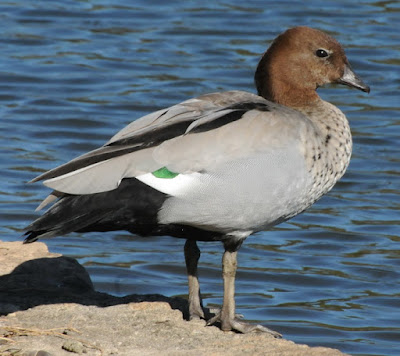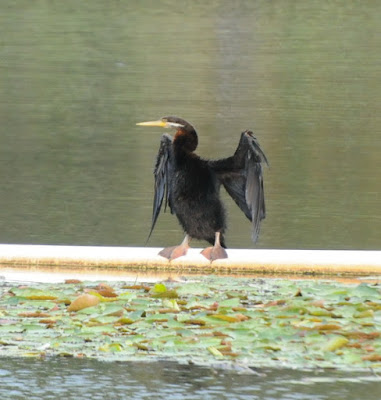So goes an old convict song, dating perhaps back to the 1830s.
From Sydney, we flew north to Brisbane on April 4, 2011, for a stay with Eileen's friend Sue. Sue works at the University of Queensland and lives not far away, near the Brisbane River (fortunately for her, just above the level of the floods that had devastated the area a few months before). While we stayed there, I took several short early morning walks along the riverbank to the campus, where two large artificial ponds attracted a host of water birds.
The Pacific Black Duck (Anas superciliosa) is a typical dabbler, the Australasian version of the Mallard (Anas platyrhynchos). Indeed, the two hybridize in New Zealand, where Mallards have been introduced. Unlike the Mallard (but like most of its other near relatives), though, both males and females are comparatively dull-coloured (though handsomely-marked, I think, on the face).
The only diving duck on the ponds - indeed, the only one in Australia - was the Hardhead or Australian White-eyed Duck (Aythya nyroca). Exactly why this bird is called a Hardhead I have been unable to discover, though perhaps it may be because its sleek, brown head does look as though it had been carved from polished wood. Other than that, there is nothing particularly hard-headed about it. Though it is a diver, it is not a fisher; in fact, according to Harry Frith's classic Waterfowl in Australia, it is primarily a vegetarian (as are its relatives in other parts of the world).
For anyone who has wondered about the difference between ducks and geese, may I present the Maned Goose (Chenonetta jubata), also known as the Australian Wood Duck. Take your choice; the names "duck" and "goose" were coined by Europeans who, at the time, had no idea that creatures such as this existed. Like true geese, it spends much of its time on land, where it grazes in grasslands and crop fields, but it is less closely related to them than it is to the very different-looking North American Wood Duck (Aix sponsa).
The Black-throated or Australasian Little Grebe (Tachybaptus novaehollandiae) replaces the widespread Little Grebe (T. ruficollis) of much of the rest of the Old World. Except for its black throat, it looks and acts very much like it.
I cannot help thinking, whenever I see a grebe, of my late graduate supervisor at the University of Michigan, Robert W. Storer (1914-2008). Dr. Storer adored grebes, and was certainly the leading authority on the family. I remember his excitement when a splendid new species of grebe, the Hooded Grebe (Podiceps gallardoi), turned up in southern Argentina (he was on a plane to Patagonia shortly afterward). A fine and kindly man, and one I miss.
Australia's two smaller cormorants are common on inland fresh waters, and they were both present at the university ponds. Commonest were Little Black Cormorants (Phalacrocorax sulcirostris), the birds lined up in a row at the top of this entry.
This is a Little Pied Cormorant (Phalacrocorax melanoleucos). In New Zealand this species also comes in an all-black morph, but in Australia all the birds are pied, making identification much easier, though the shorter, thicker beak of the Little Pied is quite unlike that of the Little Black.
I only saw one Australian Darter (Anhinga novaehollandiae), a handsome male.
Australian White Ibises (Threskiornis molucca) are common city birds in Brisbane, Sydney and Melbourne - in the last two cities, partly as a result of population explosions of animals released from zoos.
Dusky Moorhens (Gallinula tenebrosa) are handsome birds, missing the white side-stripe of moorhens elsewhere in the world. Notice the brilliantly-coloured and patterned feet.
The Australian race of Purple Swamphen (Porphyrio porphyrio melanotus) is the bird called "pukeko" in New Zealand, but in Australia it is much more of a water bird. Notice the brilliant green speculum, or wing-patch, on the Pacific Black Duck in the upper photo.
Masked Lapwings (Vanellus miles) stalked about on the grass around the ponds, showing off their rather startling yellow facial wattles.
Birds, of course, are not the only attractions for a naturalist poking around the edges of a pond. This is a female Fiery Skimmer (Orthetrum villosovittatum), a common Brisbane dragonfly - the male is a striking creature, as its English name implies.
The Blue Riverdamsel (Pseudagrion microcephalum) is one of three very similar blue damselflies common around Brisbane. In the upper picture an unattached male considers his chances of horning in on a mating pair - a common sight with damselflies.
The borders of ponds are also good places to find the Eastern Water Dragon (Physignathus l. lesueurii), where it sits looking, as usual, rather smug.
























No comments:
Post a Comment